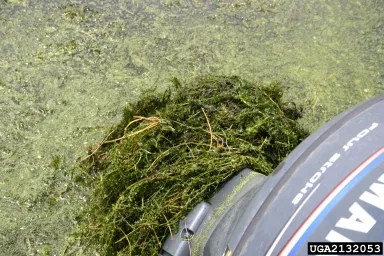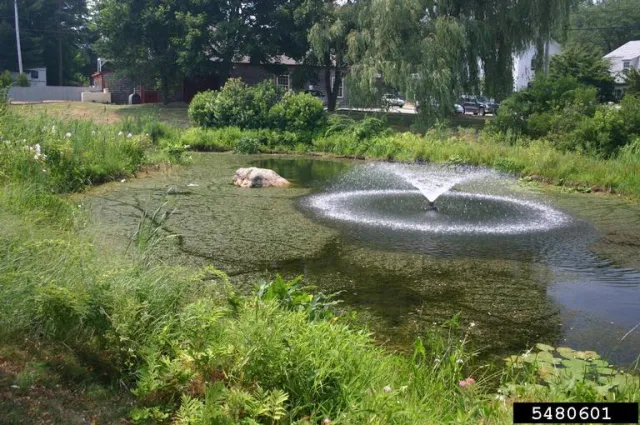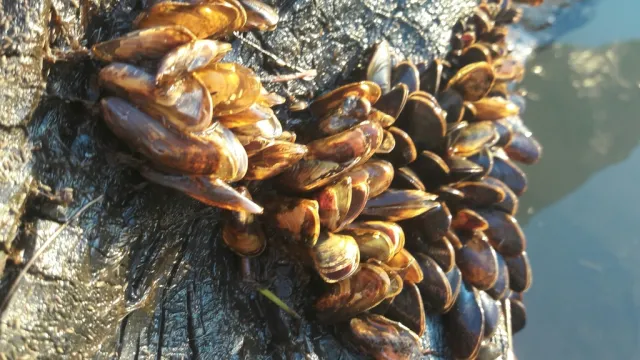A few strands of thin, feathery, green plants growing under the dock didn’t catch anyone’s attention last spring. But those strands spread quickly and within months the lake’s calm waters were tangled in mats of the feathery Eurasian watermilfoil, an aggressive aquatic plant that grows quickly and clogs everything in its path. The repercussions of this invasion then rippled through the community; swimming areas were closed for the summer, anglers returned empty-handed, boats were quarantined, and the local ecosystem was disrupted.
This isn't just an isolated incident; it’s happening across California. Aquatic invasive species are spreading faster than ever, infesting our ponds, creeks, reservoirs, lakes, and rivers. Now is the time to learn about aquatic invasive species; what they are, how they spread, and what we can do to stop them. When we understand the issue, we can make smart choices and protect California’s waters.

Impacts from Invasive Aquatic Species
Aquatic invasive species, like plants, fish, and mussels, are non-native species that live in water (freshwater or marine) that can cause harm to the environment, impact the economy, or negatively affect human health. Once established in an ecosystem, they are incredibly hard to remove, requiring eradication and management efforts that cost millions of dollars. They can outcompete native species, alter habitats, and even transmit diseases.
How Aquatic Invaders Spread
These species often don't spread on their own. They are commonly introduced (brought in) to new areas through human activities. Some of the most harmful aquatic invasive species found in California originated as aquarium plants and pets or were ornamental species used in water gardens and ponds. Aquatic invasive species can be spread unintentionally when:
- Aquarium water or pets are dumped in storm drains or waterways
- Water gardens or ponds overflow
- Leftover bait is discarded into nearby waterways
- Mussels or plant fragments hitchhike on boats, equipment, or in ballast water

The ease of buying and selling plants and animals online makes it simple to import exotic species, especially for aquarium and water garden use. In one concerning case, moss balls, a common aquarium item, were found to carry invasive zebra and quagga mussels, which were unknowingly introduced to aquariums and water gardens by unsuspecting consumers.
California’s Current Threats
Aggressive aquatic invasive plants like Eurasian watermilfoil, hydrilla, and caulerpa have been found in creeks, lakes, rivers, and even stormwater channels across the state. These invaders grow fast, clogging pipes, tangling boat motors, and choking out native plants. They are nearly impossible to control. Read more about the status and management of aquatic invasive plants in California on the State Parks Division of Boats and Waterways website.
Agencies across California are working to stop the spread of golden mussels, another invasive threatening our waterways. These aggressive invaders were accidentally introduced to California waterways after escaping from a ship’s ballast water. Golden mussels join the lineup of hitchhiking invasives troubling our state, and like the invasive zebra and quagga mussels, they require ongoing boat inspections to slow their spread. Learn more about invasive mussels and other invasive species threatening California’s waterways by visiting the California Department of Fish and Wildlife’s website.

Everyone Can Help
Be Proactive!
To help prevent the spread of invasive species, start by checking for any local alerts before visiting lakes, reservoirs, or natural areas. Share what you know by talking with fellow gardeners, boaters, and community members about the risks and how we can all help. Simple actions like posting “Clean, Drain, Dry” signage at marinas, garden clubs, or neighborhood ponds can raise awareness where it matters most.
For more guidance, turn to trusted resources like the Clean, Drain, Dry campaign, UC IPM website, or your local UC Master Gardener program.
3 Smart Steps for Prevention
- Garden with Purpose
- Avoid planting invasive water plants in your backyard ponds and aquariums. Aquatic plants available for sale in other states may be invasive and even illegal in California. Do your research and always buy from a reputable source.
- Choose native or non-invasive alternatives recommended by your local nursery, California Invasive Plant Council (Cal-IPC) or UC Master Gardeners.
- Never dump pond or aquarium water into the street, storm drains, or creeks. Check that your water garden or pond will not flood into local waterways.
- If you spot an unusual plant or animal growing or floating in your local waterway, report it!
- Don’t Let It Loose
- Never release pet fish, snails, turtles, or plants into public water features, lakes, or rivers.
- Rehome or surrender unwanted aquatic pets through proper programs.
- Visit Habitattitude for more information and resources about responsible pet ownership to prevent pets from becoming invasive.
- Clean, Drain, Dry: Even in the City!
- If you head to a lake, river, or reservoir, even with a kayak or paddleboard, clean, drain, and dry your gear after each trip.
- This also applies to gear used in neighborhood creeks, parks, or splash pads!
- Look for and comply with watercraft inspection stations, especially near high-risk lakes and reservoirs. These checkpoints are designed to keep invasive species from hitching a ride into sensitive water systems.
Prevent the spread of aquatic invasive species by using this checklist to properly clean, drain, and dry your equipment after visiting a freshwater lake, river or stream:
- Clean any visible mud, plants, fish, or mussels from watercraft and equipment
- Drain all water, including from lower outboard unit, ballast, live-well, buckets, and anything else that contains water
- Dry everything for at least five days or with a towel before reuse
- Dispose of debris and unwanted bait, worms, and fish parts in the trash
- Report any mussels or suspected invasive species you find to the California Department of Fish and Wildlife hotline at (866) 440-9530 or email: Invasives@wildlife.ca.gov and to the local marina manager or harbormaster.
Invasive aquatic species are more than just a nuisance, they threaten recreation, wildlife, and water infrastructure across California. But with informed choices and simple preventative actions, each of us can play a role in protecting our local waterways. By learning how invasives spread and committing to responsible habits, we can keep our creeks, lakes, and rivers healthy for generations to come.

